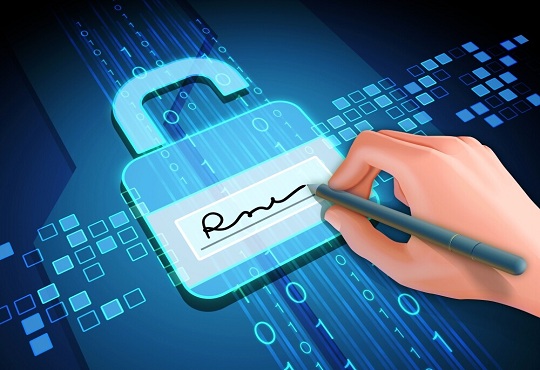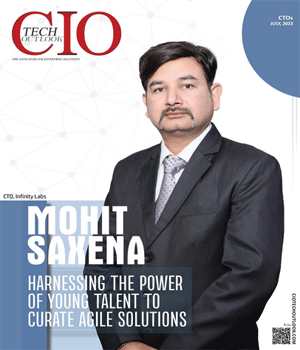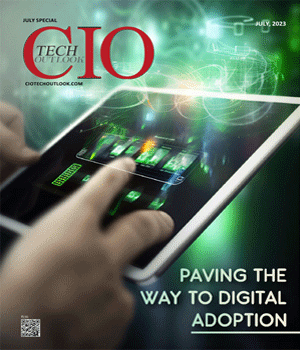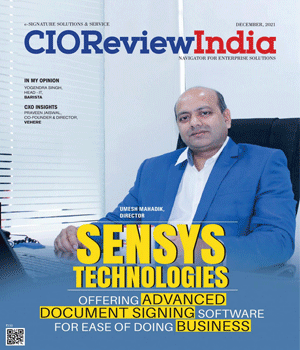
Ensuring Data Authenticity through Digital Signatures
Janifha Evangeline | Wednesday, 12 May 2021, 03:14 IST

The digital signature market is anticipated to reach USD 14.1 billion by 2026. Major factors bolstering this market growth include the initiatives and transitions taken by Governments toward digitalization. According to West’s Encyclopedia of American Law, “a signature is a mark or sign made by an individual on an instrument or document to signify knowledge, approval, acceptance or obligation.” The purpose of it is “to authenticate a writing, or provide notice of its source, and to bind the individual signing the writing by the provisions contained in the document.”
There is a strong adoption of advanced technologies in organizations in the Banking, Financial Services, and Insurance sector in recent years, as they deal with critical data and information. This industry is witnessing digital transformation at every level of its operation owing to the growing customer demands that are changing rapidly, hence, the implementation of various online services has soared and these include mobile banking, internet banking, and stock trading.
While the BFSI (Banking, Financial Services, and Insurance) industry mainly focuses on understanding and getting to know the digital consumer behavior and preferences by leveraging customer-centric business applications, the digital signatures simplify complex business processes of organizations in the Banking, Financial Services, and Insurance domain. This is achieved by providing intense security and more turnaround time for customer onboarding. Therefore, the digital signature is gaining immense popularity among organizations in the BFSI industry.
Importance of validating the digital signature on Form 16
As soon as you receive the TDS certificate which is Form 16 from your employer, the first thing an employee should examine and ensure is that the digital signatures on the certificate being validated. It is imperative or crucial to validate the digital signature in order to check the authenticity of Form 16. Archit Gupta, Founder & CEO of Cleartax.com states that “People tend to ignore this, but a digital signature is just like a physical signature; a digital sign makes Form 16 a legal document. A digital signature can also be verified. Validating a digital signature ensures it is from a trusted source and has not been modified after signing. Therefore, it helps make sure that your Form 16 is authentic.”
Challenges in Digital Signature Industry
Although digital signature solutions help in automating the business processes and help in bringing about digital transformation, the users want business processes to be user-friendly, offer flexible accessibility with high security, and be compatible with all rules and regulations. Digital signature solutions meet these requirements by providing security and boost trust in business processes. However, the business practices, which need to route documents and then signed by all signatories with additional suggestions or changes is a long process that consumes time and effort. Therefore, overcoming these is becoming a huge hindrance or challenge in this landscape.
Integration of Blockchain in Digital Signatures
This powerful technology has made its entry into every industry or landscape that requires digital security. And now integration of blockchain in digital signatures is one of the major trends in the digital signature market as well. While, this is being carried out in order to secure data against forgery and other frauds, the usage of blockchain technology not only facilitates in eliminating a 3rd party firm that includes a certification authority, it also makes it highly impossible for users to wipe off their fingerprints if they corrupt an entry.
By integrating blockchain with digital signatures, any digital object can be signed, multiple users can sign a document, which is received by the users. once everyone has signed it, the documents can be verified independently and the requirement for cost-intensive certificates is eliminated.
Digital Memorabilia
“just setting up my twttr” – the first-ever tweet on Twitter! This tweet is on sale after Jack Dorsey - listed this post as a unique digital signature on a website. The website sells tweets as NFTs (non-fungible tokens). Jack Dorsey is the CEO of the American microblogging and social networking service and one of the world’s most popular social media sites. The post that was sent from Dorsey’s account in March 2006, received offers recently in March 2021. The offer went as high as USD 88,888.88 within minutes of the Twitter co-founder tweeting a link to the listing on ‘Valuables by Cent’ – which is a tweets marketplace.
Old offers for the tweet showed that although the tweet was on sale in December, the listing got more bidders after Jack Dorsey’s tweet on the 5th of March, 2021. The 15-year-old tweet of Jack Dorsey is one of the most renowned tweets ever on Twitter. Moreover, this tweet could attract bidders to pay a high price for the digital memorabilia, while the highest bid for this tweet stood at USD 2 million on the 6th of March 2021. This updated offer was made by the CEO of BitTorrent and founder of TRON Foundation and Pelwo app, Justin Sun. Justin won an auction for Warren Buffet’s charity dinner.
“I have updated my offer to 2 million USD,” Sun tweeted.
Valuables, which was launched 5 months ago, compares the purchasing of tweets with purchasing an autographed baseball card. “There is only one unique signed version of the tweet, and if the creator agrees to sell, you can own it forever” NFTs or Non-fungible tokens are nothing but the digital files that serve as digital signatures in order to certify who owns photos and videos and other online media. As per the Valuables website, what a tweet’s buyer would be getting is an autographed digital certificate that is signed using cryptography. And this will consist of metadata of the original tweet. Lastly, the tweet will continue to remain on Twitter.
Industry growth drivers
Although Digital signatures are complex to tamper when compared to handwritten signatures, they can be considered as the replica of handwritten signatures. Also, there are possibilities of modifying paper documents after signing them, whereas, it is not possible or virtually impossible to manipulate a digital signature, thus it assures the authenticity of data.
Future of Digital Signatures market
Until 2030, the highest Compound Annual Growth Rate in the digital signature sector is projected to be observed in the BFSI division. This is owing to the increasing acceptance of digital signatures for digital payments and the decisions to make financial transactions highly secure. Furthermore, the enterprises in this landscape are taking more efforts to decrease their paperwork by replacing them with auditable and accurate workflows that are powered by digital signatures. In the coming future, the fastest growing market will be Asia-Pacific as there are huge concerns related to cybersecurity and the real need to decrease the number of frauds in the region.
CIO Viewpoint
EdTech Business Models: Unlocking Success in...
By Atulya Kaushik, Co-founder and CEO of PrepInsta
CIO's Role in Driving Enterprise Sustainability
By Manoj Deorukhkar, Chief Information Officer at Sterling & Wilson Limited
Transforming employee experience through the...
By Prasad Ramakrishnan, CIO of Freshworks
CXO Insights
How leveraging technology solutions automates...
By Bimlesh Prasad
Why Digitalization is Crucial to Staying...
By Janifha Evangeline
How Digitization is Shattering Real Estate...












